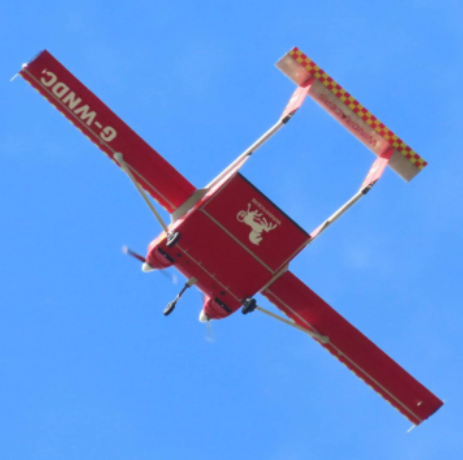UK researchers are exploring the potential of utilising drone swarms to extinguish fires before they escalate into wildfires.
A collaborative team of firefighters, scientists, and engineers is developing a system that would enable up to 30 autonomous drones to detect and suppress fires using artificial intelligence.
While drones are already employed in firefighting to locate hidden fires and evaluate safety hazards, this research introduces a novel approach by integrating unpiloted drone technology with swarm engineering specifically for firefighting. Although still in the testing phase and not yet deployed in actual wildfires, the team believes it is pioneering the use of drone swarms in this context.
The drones intended for future firefighting missions are substantial twin-engine aircraft with a wingspan of 9.5 metres (31 feet) and a significant capacity for carrying water or fire retardant. Recently, the BBC observed a small-scale trial at an airfield in Cornwall, where one of these large drones, accompanied by two smaller test drones, autonomously identified and approached a controlled fire set in a bin.
In these early tests, the drones simulated the process of approaching and extinguishing a fire by descending towards the bin. The researchers aim to harness the drones’ lifting power to carry water or retardant for real firefighting scenarios. Notably, these drones are designed to operate without human intervention, adjusting to changing flight conditions independently.
The next phase of the project focuses on swarm engineering, which involves coordinating multiple drones to work together effectively in real-world applications. The lead researcher highlights the potential for AI-driven drone swarms to monitor vast areas, such as the size of California, enabling quicker detection and response to remote fires. Similar to a flock of birds that can fly in unison, a drone swarm can adapt to changing conditions, ensuring continuous coverage even if some drones need to refuel.
The twin-engine drones were developed by the UK company Windracers, which is also testing its aircraft in Antarctica to assist in climate change research. While regulatory approval would be required for real-world deployment, the primary goal of these drone swarms is to prevent small fires from developing into uncontrollable wildfires.
According to the National Fire Chiefs Council (NFCC), most wildfires in the UK are caused by human activities, such as improper use of barbecues, careless disposal of smoking materials, or deliberate arson. The NFCC notes that climate change is contributing to longer periods of dry, warm weather in the UK, which increases the likelihood of small fires becoming major incidents.
Since 2021, there have been over 1,500 wildfires in England and Wales, according to new data from National Resilience, which coordinates responses to significant, serious, or catastrophic events.
Original article source:
FAQ
- What are drone swarms?
Answer: A drone swarm is a group of drones that operate together, often autonomously, and are coordinated to perform tasks as a single unit. They communicate with each other to share data and optimize their collective actions.
- How can drone swarms be used to fight wildfires?
Answer: Drone swarms can be deployed to monitor fire-prone areas, detect early signs of wildfires, assess fire spread in real-time, and even deliver fire-retardant materials to suppress fires. They can operate in dangerous environments where human intervention is risky.
- What are the advantages of using drone swarms over traditional methods?
Answer: Drone swarms can cover large areas quickly, access remote or difficult terrains, operate in hazardous conditions without risking human lives, provide real-time data and situational awareness, and act autonomously to make rapid decisions.
- Can drone swarms operate autonomously in wildfire scenarios?
Answer: Yes, advanced AI algorithms can enable drone swarms to autonomously navigate, avoid obstacles, coordinate with each other, and perform tasks like identifying hotspots or deploying fire suppression agents without human intervention.
- How do drones communicate within a swarm?
Answer: Drones in a swarm communicate using wireless networks, typically through ad-hoc or mesh networking, where each drone acts as a node to relay information. This ensures robust communication even in challenging environments.
- What types of sensors do drone swarms use for wildfire detection?
Answer: Drone swarms can be equipped with various sensors, including thermal cameras, infrared sensors, LiDAR, and optical cameras, to detect heat signatures, smoke, and other indicators of wildfire.
- How do drone swarms deliver fire retardants?
Answer: Drones can be equipped with payload delivery systems that carry and disperse fire retardants, water, or other suppressants. They can target specific areas with precision, guided by real-time data.
